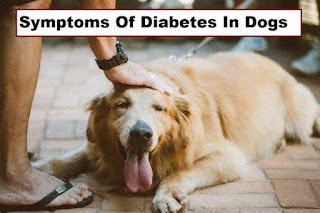Diabetes in Dogs: Symptoms
What causes diabetes in dogs?
Diabetes is a chronic disease that can affect dogs and cats, as well as other animals (such as apes, pigs, and horses). Diabetes can't be cured, but it can be managed well.
 |
| Symptoms and Signs of Diabetes in Dogs |
Diabetes in Dogs: What Are the Symptoms and Signs?
The first indications The owner may occasionally notice the following symptoms, which may be early warning signs of diabetes:
Excessive thirst is a condition that causes a person to be constantly thirsty.
The dog may drink more frequently and the water bowl may be emptied more frequently.
Urination has increased. The dog may constantly ask to go outside and may start having "accidents" within the house. The body tries to get rid of excess sugar by sending it out through urine, along with water that binds to the sugar. This causes increased urination (and thirst).
Loss of weight. Despite eating normal portions, the dog can lose weight. This is due to the dog's inability to convert nutrients from its food effectively.
Appetite increase. Even if the dog eats a normal amount of food, the dog may be constantly hungry because the body's cells aren't getting enough glucose.
Diabetes Symptoms that are less obvious include:
Infections that recur
Weakness
Inadequate coat quality
Cataracts
Seizures
What exactly is Diabetes?
Diabetes mellitus, also known as diabetes, is a condition in which the body is unable to use glucose (a type of sugar) normally. Glucose is the primary source of energy for the cells in the body. The pancreas produces insulin, which is primarily responsible for controlling blood glucose levels.
Sugars are one of the nutrients absorbed from food as it passes through the intestines during digestion. Sugars are transported into cells lining the intestines and converted into simple sugars (including glucose). The simple sugars are then absorbed into the bloodstream and circulated throughout the body's tissues and cells. Insulin is required for glucose transport from the bloodstream to the cells. When there is insufficient insulin or the body is unable to use the insulin, glucose levels in the blood rise to dangerously high levels, a condition known as hyperglycemia. When blood glucose levels reach a certain level, the glucose overflows into the urine (a condition known as glucosuria) and draws large amounts of water with it.
This is why diabetic pets frequently drink more water and urinate more frequently and in greater quantities.
Diabetes mellitus is a chronic carbohydrate metabolism disorder caused by a relative or absolute insulin deficiency.
The majority of cases of spontaneous diabetes occur in middle-aged dogs and older cats. Diabetes can strike dogs and cats at any age. Diabetic dogs, on the other hand, are typically 4-14 years old, with the majority being diagnosed between the ages of 7 and 10. Females are affected twice as frequently as males in dogs, and the incidence appears to be higher in certain small breeds such as Miniature Poodles, Dachshunds, Schnauzers, Cairn Terriers, and Beagles, but any breed can be affected.
If untreated, the condition can cause cataracts, leg weakness (neuropathy), malnutrition, ketoacidosis, dehydration, and death.





0 Comments